Tunability Investigation in the BaTiO3-CaTiO3-BaZrO3 Phase Diagram Using a Refined Combinatorial Thin Film Approach
Abstract
:1. Introduction
2. Materials and Methods
3. Results
3.1. Composition Gradient Characterization
3.2. Fast Intitial C(V) Screening
4. Discussion
5. Conclusions
Supplementary Materials
Author Contributions
Funding
Institutional Review Board Statement
Informed Consent Statement
Data Availability Statement
Acknowledgments
Conflicts of Interest
References
- Tagantsev, A.K.; Sherman, V.O.; Astafiev, K.F.; Venkatesh, J.; Setter, N. Ferroelectric materials for microwave tunable applications. J. Electroceram. 2003, 11, 5–66. [Google Scholar] [CrossRef]
- Bao, P.; Jackson, T.J.; Lancaster, M.J. Barium strontium titanate thin film varactors for room-temperature microwave device applications. J. Phys. D 2008, 41, 063001. [Google Scholar] [CrossRef]
- Subramanyam, G.; Cole, M.W.; Sun, N.X.; Kalkur, T.S.; Sbrockey, N.M.; Tompa, G.S.; Guo, X.; Chen, C.; Alpay, S.P.; Rossetti, G.A., Jr. Challenges and opportunities for multi-functional oxide thin films for voltage tunable radio frequency/microwave components. J. Appl. Phys. 2013, 114, 191301. [Google Scholar] [CrossRef]
- Cole, M.W.; Joshi, P.C.; Ervin, M.H. La doped Ba1-xSrxTiO3 thin films for tunable device applications. J. Appl. Phys. 2001, 89, 6336. [Google Scholar] [CrossRef]
- Cole, M.W.; Joshi, P.C.; Ervin, M.H.; Wood, M.C.; Pfeffer, R.L. The influence of Mg doping on the materials properties of Ba1−xSrxTiO3 thin films for tunable device applications. Thin Solid Films 2000, 374, 34–41. [Google Scholar] [CrossRef]
- Horwitz, J.S.; Chang, W.; Carter, A.C.; Pond, J.M.; Kirchoefer, S.W.; Chrisey, D.B.; Levy, J.; Hubert, C. Structure/property relationships in ferroelectric thin films for frequency agile microwave electronics. Integr. Ferroelectr. 1998, 22, 279–289. [Google Scholar] [CrossRef]
- Wang, R.-V.; McIntyre, P.C.; Baniecki, J.D.; Nomura, K.; Shioga, T.; Kurihara, K.; Ishii, M. Effect of Y doping and composition-dependent elastic strain on the electrical properties of (Ba,Sr)TiO3 thin films deposited at 520 °C. Appl. Phys. Lett. 2005, 87, 192906. [Google Scholar] [CrossRef]
- Liu, G.; Wolfman, J.; Autret-Lambert, C.; Sakai, J.; Roger, S.; Gervais, M.; Gervais, F. Microstructural and dielectric properties of Ba0.6Sr0.4Ti1−xZrxO3 based combinatorial thin film capacitors library. J. Appl. Phys. 2010, 108, 114108. [Google Scholar] [CrossRef]
- Cole, M.W.; Hubbard, C.; Ngo, E.; Ervin, M.; Wood, M. Structure–property relationships in pure and acceptor-doped Ba1−xSrxTiO3 thin films for tunable microwave device applications. J. Appl. Phys. 2002, 92, 475. [Google Scholar] [CrossRef]
- Jeon, Y.-A.; Seo, T.-S.; Yoon, S.-G. Effect of Ni doping on improvement of the tunability and dielectric loss of Ba0.5Sr0.5TiO3 thin films for microwave tunable devices. Jpn. J. Appl. Phys. 2001, 40, 6496. [Google Scholar] [CrossRef]
- Liu, W.; Ren, X. Large piezoelectric effect in Pb-free ceramics. Phys. Rev. Lett. 2009, 103, 257602. [Google Scholar] [CrossRef]
- Jiang, L.L.; Tang, X.G.; Li, Q.; Chan, H.L.W. Dielectric properties of (Ba,Ca)(Zr,Ti)O3/CaRuO3 heterostructure thin films prepared by pulsed laser deposition. Vacuum 2009, 83, 1018–1021. [Google Scholar] [CrossRef]
- Piorra, A.; Petraru, A.; Kohlstedt, H.; Wuttig, M.; Quandt, E. Piezoelectric properties of 0.5(Ba0.7Ca0.3TiO3)—0.5[Ba(Zr0.2Ti0.8)O3] ferroelectric lead-free laser deposited thin films. J. Appl. Phys. 2011, 109, 104101. [Google Scholar] [CrossRef]
- Benabdallah, F.; Simon, A.; Khemakhen, H.; Elissalde, C.; Maglione, M. Linking large piezoelectric coefficients to highly flexible polarization of lead free BaTiO3-CaTiO3-BaZrO3 ceramics. J. Appl. Phys. 2011, 109, 124116. [Google Scholar] [CrossRef]
- Puli, V.S.; Kumar, A.; Chrisey, D.B.; Tomozawa, M.; Scott, J.F.; Katiyar, R.S. Barium zirconate-titanate/barium calcium-titanate ceramics via sol–gel process: Novel high-energy-density capacitors. J. Phys. D Appl. Phys. 2011, 44, 395403. [Google Scholar] [CrossRef]
- Kang, G.; Yao, K.; Wang, J. (1 − x)Ba(Zr0.2Ti0.8)O3–x(Ba0.7Ca0.3)TiO3 Ferroelectric Thin Films Prepared from Chemical Solutions. J. Am. Ceram. Soc. 2012, 95, 986–991. [Google Scholar] [CrossRef]
- Puli, V.S.; Pradhan, D.K.; Adireddy, S.; Martínez, R.; Silwal, P.; Scott, J.F.; Ramana, C.V.; Chrisey, D.B.; Katiyar, R.S. Nanoscale polarisation switching and leakage currents in (Ba0. 955Ca0. 045)(Zr0. 17Ti0.83)O3 epitaxial thin films. J. Phys. D: Appl. Phys. 2015, 48, 355502. [Google Scholar] [CrossRef]
- Keeble, D.; Benadallah, F.; Thomas, P.; Maglione, M.; Kreisel, J. Revised structural phase diagram of (Ba0.7Ca0.3TiO3)-(BaZr0.2Ti0.8O3). Appl. Phys. Lett. 2013, 102, 92903. [Google Scholar] [CrossRef]
- Xue, D.; Gao, J.; Zhou, Y.; Ding, X.; Sun, J.; Lookman, T.; Ren, X. Phase transitions and phase diagram of Ba(Zr0.2Ti0.8)O3-x(Ba0.7Ca0.3)TiO3 Pb-free system by anelastic measurement. J. Appl. Phys. 2015, 117, 124107. [Google Scholar] [CrossRef]
- Acosta, M.; Novak, N.; Rojas, V.; Patel, S.; Vaish, R.; Koruza, J.; Rossetti, G.A., Jr.; Rödel, J. BaTiO3-based piezoelectrics: Fundamentals, current status, and perspectives. App. Phys. Rev. 2017, 4, 041305. [Google Scholar] [CrossRef]
- Yamada, Y.; Fukumura, T.; Ikeda, M.; Ohtani, M.; Toyosaki, H.; Ohtomo, A.; Matsukura, F.; Ohno, H.; Kawasaki, M. Fabrication of Ternary Phase Composition-Spread Thin Film Libraries and Their High-Throughput Characterization: Ti1− x− yZrxHfyO2 for Bandgap Engineering. J. Supercond. 2005, 18, 109–113. [Google Scholar] [CrossRef]
- Yamamoto, Y.; Takahashi, R.; Matsumoto, Y.; Chikyowa, T.; Koinuma, H. Mathematical design of linear action masks for binary and ternary composition spread film library. Appl. Surf. Sci. 2004, 223, 9–13. [Google Scholar] [CrossRef]
- Daumont, C.; Simon, Q.; Le Mouellic, E.; Payan, S.; Gardes, P.; Poveda, P.; Negulescu, B.; Maglione, M.; Wolfman, J. Tunability, dielectric, and piezoelectric properties of Ba(1−x)CaxTi(1−y)ZryO3 ferroelectric thin films. J. Appl. Phys. 2016, 119, 094107. [Google Scholar] [CrossRef]
- Wolfman, J.; Negulescu, B.; Ruyter, A.; Niang, N.; Jaber, N. Interface combinatorial pulsed laser deposition to enhance heterostructures functional properties. In Practical Applications of Laser Ablation, 1st ed.; Yang, D., Ed.; IntechOpen Ltd.: London, UK, 2020; Volume 1, pp. 3–21. [Google Scholar]
- Ohnishi, T.; Shibuya, K.; Yamamoto, T.; Lippmaa, M. Defects and transport in complex oxide thin films. J. Appl. Phys. 2008, 103, 103703. [Google Scholar] [CrossRef]
- Mitsui, T.; Westphal, W. Dielectric and X-Ray Studies of CaxBa1−xTiO3 and CaxSr1−xTiO3. Phys. Rev. 1961, 124, 1354. [Google Scholar] [CrossRef]
- Fu, D.; Itoh, M.; Koshihara, S.-Y. Invariant lattice strain and polarization in BaTiO3–CaTiO3 ferroelectric alloys. J. Phys. Cond. Matter. 2010, 22, 052204. [Google Scholar] [CrossRef] [PubMed]
- Simon, Q.; Daumont, C.J.M.; Payan, S.; Gardes, P.; Poveda, P.; Wolfman, J.; Maglione, M. Extreme dielectric non-linearities at the convergence point in Ba1-xCaxTi1-xZrxO3 thin films. J. Alloys Compd. 2018, 747, 366–373. [Google Scholar] [CrossRef]
- Green, M.L.; Takeuchi, I.; Hattrick-Simpers, J.R. Applications of high throughput (combinatorial) methodologies to electronic, magnetic, optical, and energy-related materials. J. Appl. Phys. 2013, 113, 231101. [Google Scholar] [CrossRef]
- Bassim, N.D.; Schenck, P.K.; Otani, M.; Oguchi, H. Model, prediction, and experimental verification of composition and thickness in continuous spread thin film grown by pulsed laser deposition. Rev. Sci. Instr. 2007, 78, 072203. [Google Scholar] [CrossRef]
- Commercial Tunable Capacitor Specification Sheet. Download Product Specifications: DS11850 Parascan™ Tunable Integrated Capacitor. Available online: https://www.st.com/en/emi-filtering-and-signal-conditioning/stptic-27c4.html#documentation (accessed on 25 August 2021).
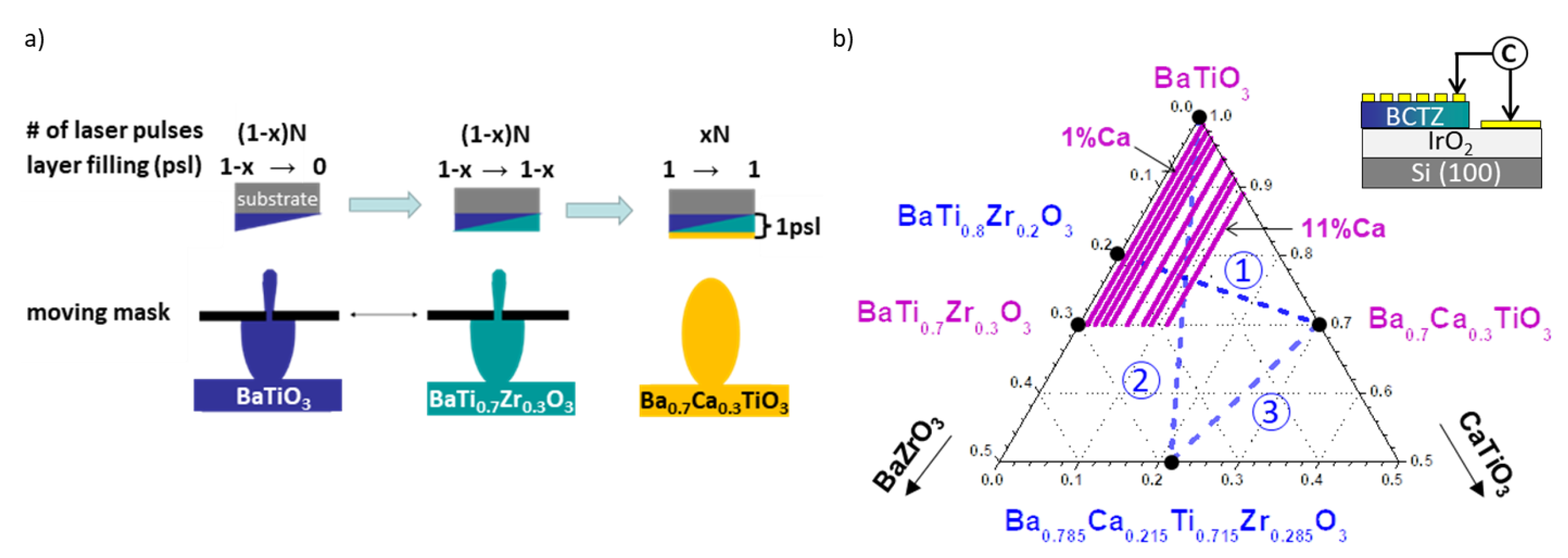
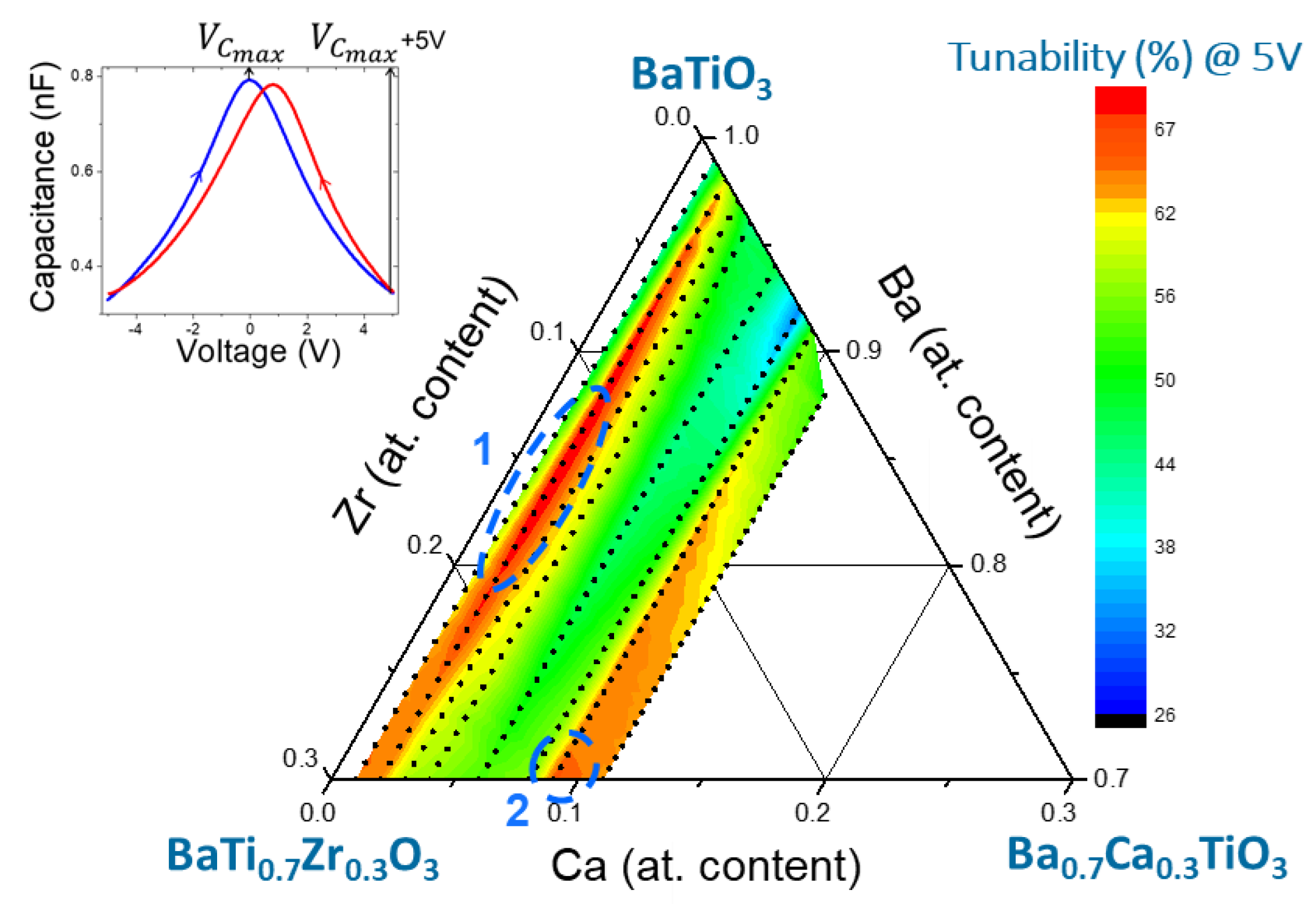
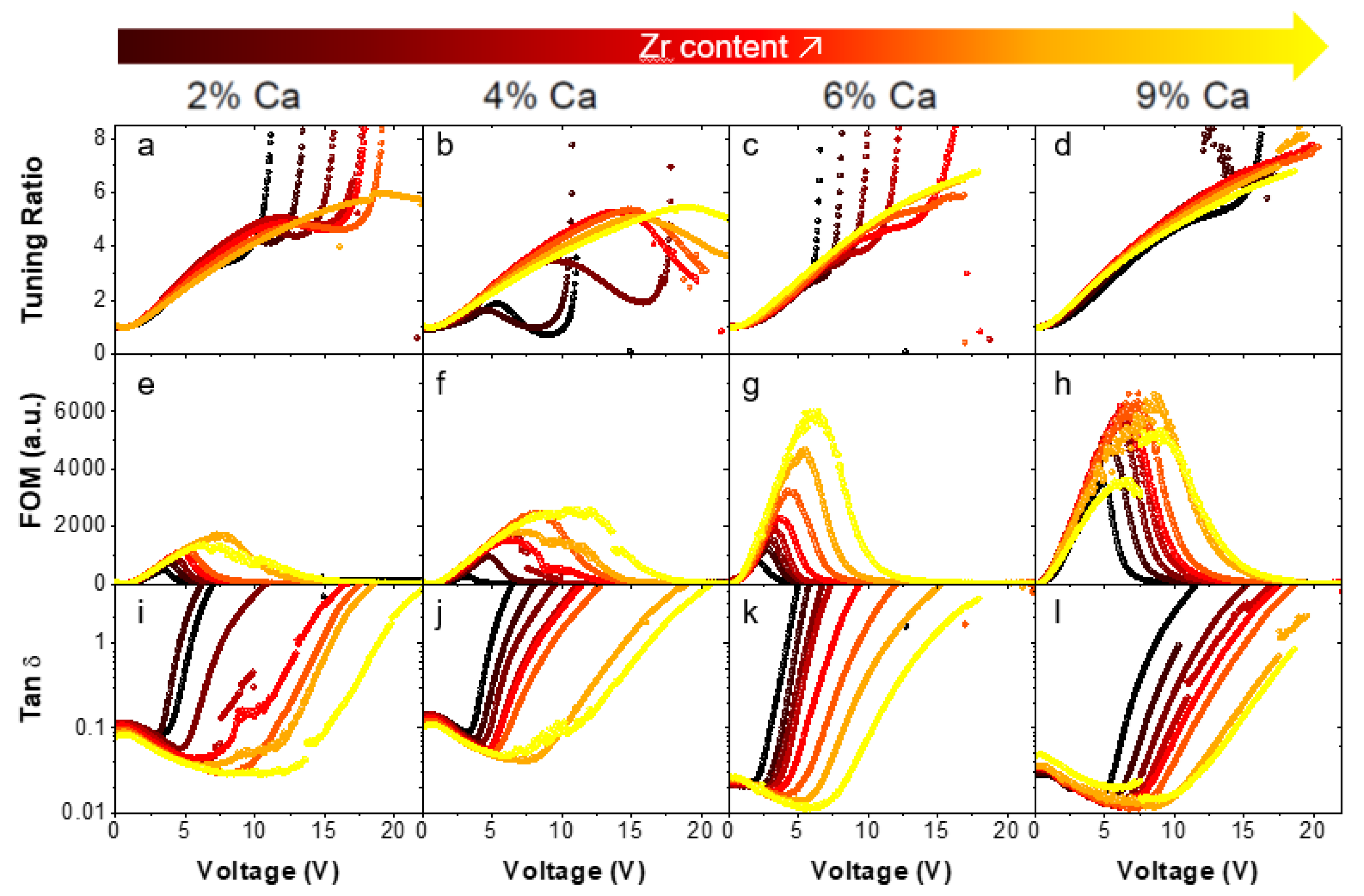
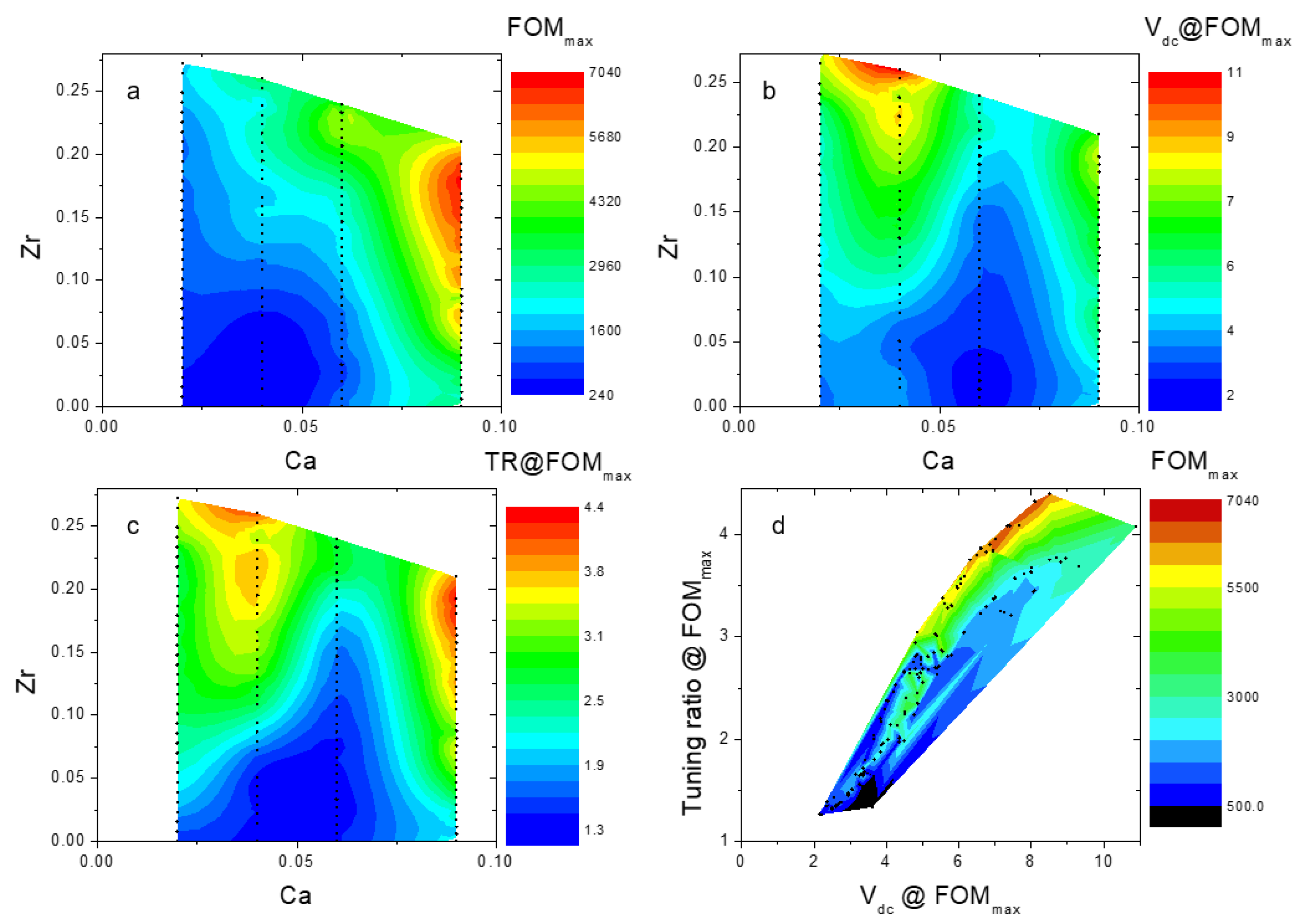
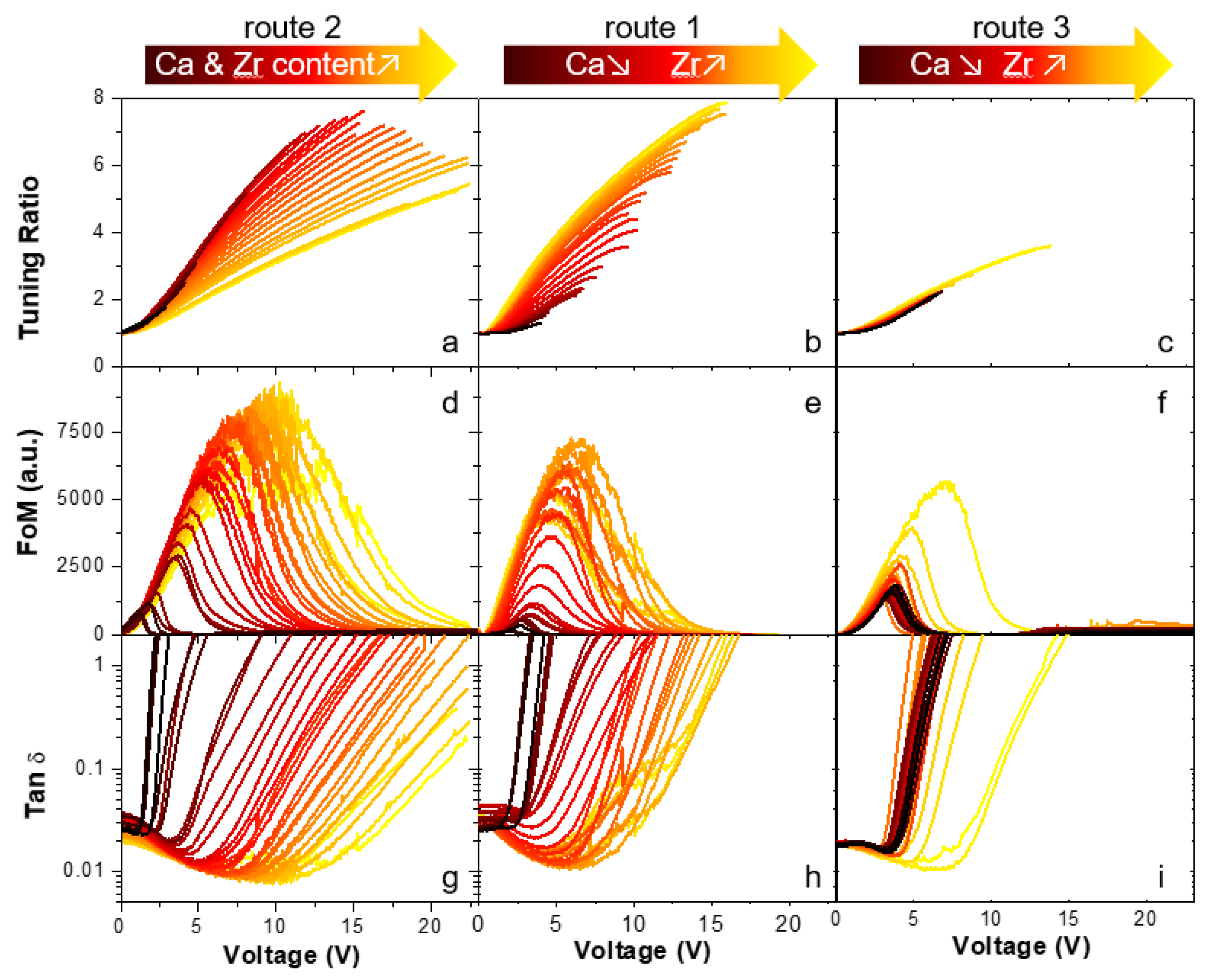

Publisher’s Note: MDPI stays neutral with regard to jurisdictional claims in published maps and institutional affiliations. |
© 2021 by the authors. Licensee MDPI, Basel, Switzerland. This article is an open access article distributed under the terms and conditions of the Creative Commons Attribution (CC BY) license (https://creativecommons.org/licenses/by/4.0/).
Share and Cite
Daumont, C.; Simon, Q.; Payan, S.; Gardes, P.; Poveda, P.; Maglione, M.; Negulescu, B.; Jaber, N.; Wolfman, J. Tunability Investigation in the BaTiO3-CaTiO3-BaZrO3 Phase Diagram Using a Refined Combinatorial Thin Film Approach. Coatings 2021, 11, 1082. https://doi.org/10.3390/coatings11091082
Daumont C, Simon Q, Payan S, Gardes P, Poveda P, Maglione M, Negulescu B, Jaber N, Wolfman J. Tunability Investigation in the BaTiO3-CaTiO3-BaZrO3 Phase Diagram Using a Refined Combinatorial Thin Film Approach. Coatings. 2021; 11(9):1082. https://doi.org/10.3390/coatings11091082
Chicago/Turabian StyleDaumont, Christophe, Quentin Simon, Sandrine Payan, Pascal Gardes, Patrick Poveda, Mario Maglione, Beatrice Negulescu, Nazir Jaber, and Jerome Wolfman. 2021. "Tunability Investigation in the BaTiO3-CaTiO3-BaZrO3 Phase Diagram Using a Refined Combinatorial Thin Film Approach" Coatings 11, no. 9: 1082. https://doi.org/10.3390/coatings11091082
APA StyleDaumont, C., Simon, Q., Payan, S., Gardes, P., Poveda, P., Maglione, M., Negulescu, B., Jaber, N., & Wolfman, J. (2021). Tunability Investigation in the BaTiO3-CaTiO3-BaZrO3 Phase Diagram Using a Refined Combinatorial Thin Film Approach. Coatings, 11(9), 1082. https://doi.org/10.3390/coatings11091082





